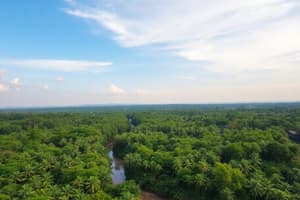Podcast
Questions and Answers
What are some key characteristics of the indigenous communities in the Amazon Basin?
What are some key characteristics of the indigenous communities in the Amazon Basin?
Traditional knowledge systems, sustainable practices, rich cultural heritage
What are some threats faced by indigenous tribes in the Amazon Basin?
What are some threats faced by indigenous tribes in the Amazon Basin?
Deforestation and encroachment of industrial development
What are some crops cultivated in the Amazon Basin by indigenous communities and small-scale farmers?
What are some crops cultivated in the Amazon Basin by indigenous communities and small-scale farmers?
Rice, manioc, bananas, cassava
How many wet seasons and dry seasons does the Amazon Basin experience annually?
How many wet seasons and dry seasons does the Amazon Basin experience annually?
What are some threats posed by climate change to the Amazon Basin?
What are some threats posed by climate change to the Amazon Basin?
What is the Amazon Basin often referred to as, due to the vast amounts of oxygen its rainforests produce?
What is the Amazon Basin often referred to as, due to the vast amounts of oxygen its rainforests produce?
How many plant species are estimated to be in the Amazon Basin?
How many plant species are estimated to be in the Amazon Basin?
How many insect species are estimated to be in the Amazon Basin?
How many insect species are estimated to be in the Amazon Basin?
What is the world's largest river by volume that flows through the Amazon Basin?
What is the world's largest river by volume that flows through the Amazon Basin?
For how long have indigenous communities lived in the Amazon Basin?
For how long have indigenous communities lived in the Amazon Basin?
Flashcards are hidden until you start studying
Study Notes
Life in the Amazon Basin: A Geographical Perspective
Sprawling over eight million square kilometers, the Amazon Basin is a vast, complex ecosystem that encompasses nine countries and harbors a diverse range of life and cultural traditions. A region of such magnitude warrants a closer look at the unique facets of life that thrive in this remarkable landscape.
Natural Diversity
With its intricate network of rivers and lush rainforests, the Amazon Basin is home to a staggering variety of plant and animal species. The region is often referred to as the "lungs of the Earth" due to the vast amounts of oxygen its rainforests produce. The Amazon River, the world's largest by volume, is a vital artery for the movement of fish, aquatic plants, and waterborne wildlife, which in turn support the broader ecosystem.
The Amazon Basin is estimated to contain approximately 40,000 plant species, 2,000 fish species, 1,300 bird species, 370 mammal species, and a staggering 2.5 million insect species. This wealth of biodiversity provides the foundation for the abundance of life within the Amazon Basin and serves as a major contributor to global ecological balance.
Indigenous Communities
Indigenous communities have called the Amazon Basin home for thousands of years. These peoples have developed intricate relationships with their natural environment, and their way of life is deeply intertwined with the diverse ecosystems that surround them. The Amazon Basin's indigenous communities are known for their traditional knowledge systems, sustainable practices, and rich cultural heritage.
The Amazon Basin is home to over 400 indigenous tribes, many of whom have been the targets of threats to their lands and ways of life, particularly due to deforestation and the encroachment of industrial development. Indigenous communities have been active in advocating for their rights, conserving their ancestral lands, and promoting sustainable development.
Agriculture and Land Use
Agriculture in the Amazon Basin is a delicate balance between traditional practices and modern innovation. Indigenous communities, as well as small-scale farmers, have utilized the region's fertile soils and extensive waterways for centuries. This agricultural diversity is evident in crops such as rice, manioc, bananas, and cassava, which are key components of local diets.
However, the Amazon Basin is also subject to large-scale deforestation and land use change. Driven by the development of agriculture, mining, and other industries, these activities have led to significant ecological degradation, posing a threat to the integrity of the Amazon Basin's ecosystems and to the livelihoods and well-being of its inhabitants.
Climate and Weather
The Amazon Basin is famed for its intense rainfall patterns and diverse climates. The region experiences two distinct wet seasons and two dry seasons throughout the year. This tropical climate fosters the growth and diversification of vegetation and wildlife, but also contributes to the region's ecological complexity and its vulnerability to climate change.
Climate change poses a significant threat to the Amazon Basin. Changes in temperature and precipitation patterns, combined with deforestation and other land use changes, can lead to the disruption of ecosystems and the degradation of critical habitats.
Conclusion
Life in the Amazon Basin is a complex interplay of natural diversity, cultural heritage, sustainable practices, and the challenges of climate change. This vast and intricate ecosystem offers a fascinating glimpse into the world's rich biodiversity and the importance of preserving our planet's natural resources. The Amazon Basin is a testament to the resilience and adaptation of its plant and animal species and the people who call it home.
Studying That Suits You
Use AI to generate personalized quizzes and flashcards to suit your learning preferences.




